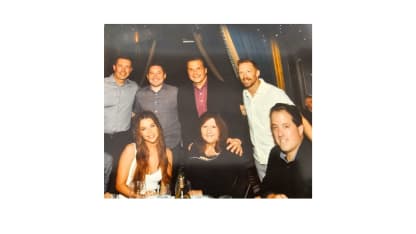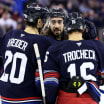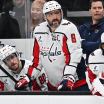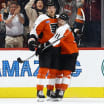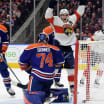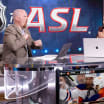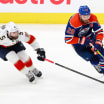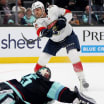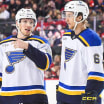As Game 5 of the 2023 Stanley Cup Final approached – the game that would ultimately hand the Cup to the Vegas Golden Knights – the TNT studio show was winding down. Anson Carter jumped in, his left hand raised, his right holding his microphone.
“Can we get a couple of quick clicks too?” Carter asked. “Z, the mama bear of TNT, just got promoted.”
They all raised their hands, Wayne Gretzky and Paul Bissonette and Henrik Lundqvist and Liam McHugh, snapping away with their fingers.
“Aw, yeah,” Bissonette said.
It was a moment of recognition for Michele Zarzaca, who had been promoted to director, talent relations at TNT that March, and who was the reason, ultimately, all five of them were sitting in those chairs, finishing out what would be their last NHL Face Off show of the Stanley Cup Final.
It’s a story that starts at a hockey game in 1972, a love affair with the sport that would survive the departures of two hockey teams from Georgia – the Atlanta Flames and Atlanta Thrashers – and one that would enable a full-circle moment when suddenly, almost unbelievably, hockey came back to her in the best possible way.
Because in 2021, nearly 50 years after that very first hockey game, Turner Sports signed on to become one of the two NHL rightsholders in the United States, along with ESPN/ABC, and Zarzaca got the chance to build her dream lineup.
She had spent endless hours watching hockey, evaluating what she liked and what she didn’t, what worked and what didn’t, who sparkled on TV and who dulled with the cameras on. This felt like a job she had been preparing for her whole life.
“I became familiar with all these voices and all these people, who I liked hearing, who I didn’t like hearing, and it was just a collection of knowledge over the years, just watching hockey,” Zarzaca said. “So as soon as I was told that I’m leading the charge on this, within moments, I had a list of people I wanted to go after.”
She knew time was of the essence, with TNT competing against ESPN for talent.
“These are the best guys in the business,” she recalled telling her boss at the time. “We need to get phone calls to them, Zoom calls. You and whomever on the executive team needs to meet these people, talk to these people, and then we need to go hire them.
“Fortunately, they listened to me.”
* * * *
Eddie Olczyk signed on. Then Kenny Albert. Then Keith Jones. They missed on Brian Boucher, who had gone to ESPN. But they got their goalie, in Darren Pang. The group that Zarzaca had long envisioned was, already, starting strong.
But perhaps her most inspired work went into the studio show, as she looked to build a group that straddled the divide between the diehard hockey fans and the casual, as she tried to marry fun with seriousness, finding the same sort of chemistry that the much-lauded “Inside the NBA” crew had found for TNT.
Wayne Gretzky was an easy yes. And then, as Zarzaca put it, “We wanted a lightning rod. Because that’s our style. Charles Barkley is our lightning rod on the NBA side. We need a lightning rod on the NHL side. Well, the biggest lightning rod out there that could probably appeal to a younger audience was going to be Paul Bissonette.”
The consensus was, let’s take a chance.
“We did,” she said. “And it worked.”
Add in Anson Carter as a stabilizer, to support Gretzky and wrangle Bissonette, and a host, which turned out to be Liam McHugh. Suddenly Rick Tocchet was out as coach of the Arizona Coyotes and Zarzaca called her boss, immediately.
“They trust my judgement,” she said. “If I didn’t have their support, things could be very different. Our look could be very different. But because they trusted me, we were able to put on the air what we have.”
Perhaps her best get, though, was a stroke of outside-the-box genius.
Henrik Lundqvist.
“What a name that would be,” she recalled thinking.
While many of the broadcasters that TNT brought in were veterans, some were not. And that’s where Zarzaca’s approach has shined, with the long-time New York Rangers goalie, in particular.
“Since day one when I joined TNT I felt so welcomed and taken care of and it all starts with Z,” Lundqvist wrote.
That has always been the aim, to ensure that players feel that they can speak freely, that they can call out what they need to. And Zarzaca said she has seen “tremendous” growth in Lundqvist over his time on the show, including the embrace of “Angry Hank,” when he at times disagrees with the play of younger goalies.
“They’re in the safe zone and they know we all have their back,” she said. “It took Henrik a little bit of time to get comfortable and to realize that we all have his back and we’re not going to put him in a situation in which he’s uncomfortable. We promised him that and we’ve delivered on that.”
And he, too, has delivered.
“What’s cool is maybe you wouldn’t have thought of a person like Lundqvist in that role because, let’s be honest, when you think of Lundqvist you think ‘sophistication’ and ‘dignified’ and I don’t know that those are the first two words that come to mind when you think of our show,” McHugh said, laughing.
It’s not that she – or they – have coached him. It’s that they’ve empowered him to be himself. It’s why the talent doesn’t come to production meetings – only the hosts do, across all the sports – to keep their reactions on the show natural and unrehearsed.
“She’s such a genuine individual and she wants you to be yourself. She’s not looking to bring people in and shape and mold and have them become someone else’s vision of who they can be,” McHugh said. “I think that’s, in many ways, why the show works so well. Because everyone is exactly who they are. They’re individuals with strong opinions and strong personalities but they’re also great teammates. I think that’s somewhat rare.”

